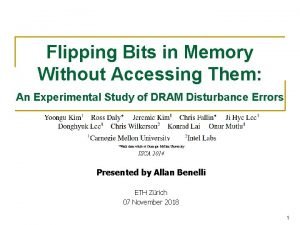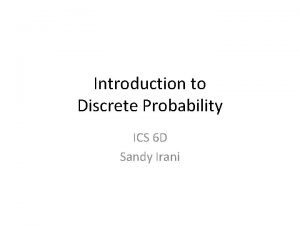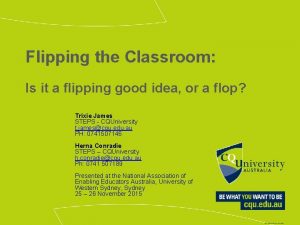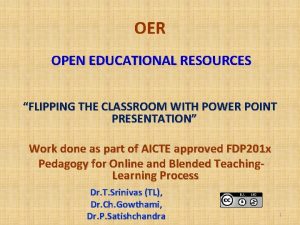Flipping the Classroom Educational Delivery Model Changes in







- Slides: 7

“Flipping the Classroom”: Educational Delivery Model Changes in an Emergency Medicine Clerkship Karademos JE 1, Damle UJ 1, Le IA 2, Chandra S 12, Piela N 12 1 Thomas Click links below to navigate to slides Introduction Methods Results Conclusions Jefferson University Hospital, 2 Sidney Kimmel Medical College BACKGROUND The emergency medicine clerkship traditionally consists of clinical patient experience and weekly didactics. With some schools adopting a blended learning model, little research has been done on its effectiveness in emergency medicine education. Starting in the 2016 -2017 academic year, the emergency medicine clerkship at Sidney Kimmel Medical College adopted a blended curriculum, with flipped classroom activities (group learning, skills sessions, and multimedia lessons) replacing traditional didactic lectures. OBJECTIVES The aim of the study is to determine whether such curriculum changes resulted in improvement in students’ knowledge acquisition and satisfaction. CLICK TO GO BACK TO KIOSK MENU

METHODS Click links below to navigate to slides Introduction Methods Results Conclusions • The study compared student knowledge and satisfaction over a period of two academic years: 2015 -2016 (traditional curriculum) and 2016 -2017 (blended curriculum). • Over the study period, each student completed an identical 50 question examination at the end of their 4 week clerkship as well as a mandatory clerkship survey sent by the Dean’s office. • The survey assessed the value of lectures on a Likert Scale of 1 (Strongly Disagree) to 7 (Strongly Agree) and the overall course impression rated from Weak to Outstanding on a 10 point scale. • Results were reported as means with standard deviations and analyzed using an independent-samples t-test and analysis of variance. Sample Student Survey Click pages to enlarge Page 1 Page 2

RESULTS Click links below to navigate to slides Key: Quantile Results from Student Examinations Mean 95 2015/2016/2017 (n=76) (n=103) Mean (%) +/-SD Scores 79. 18 +/- 6. 55 79. 92 +/- 6. 96 90 Examination Score (%) Introduction Methods Results Conclusions Examination Score vs Curriculum 85 p-value 0. 4730 80 75 Results from Student Surveys 70 65 60 55 Blended 2016/2017 Traditional 2015/2016 Curriculum Conferences Lectures Career Goals Overall 2015/2016 (n=38) Mean (%) 93. 3 97. 1 100 87. 9 2016/2017 (n=84) Mean (%) 97. 1 97. 5 100 84. 0 p-value 0. 396 0. 913 -0. 0695

RESULTS Click links below to navigate to slides Introduction Methods Results Conclusions STRAIGHT FROM THE SOURCE: STUDENTS’ RESPONSES “Didactics exceeded other clerkships with SIM lab and flipped classroom” “Friday clerkship didactics were very well planned and conducted, the skills sessions were interesting and interactive! These were the best didactics of any rotation I've taken!” “I enjoyed the hands on experience and nonlecture format even though the day was a tad too long” “The Friday morning discussions and afternoon sessions were probably the most well done formal teaching of any block I've had” STR ENG THS Strength Weakness “Large rotating student body, difficult to be able to participate in case modules “Small group sessions were very helpful for learning” WE AKN ESS ES “Friday didactics were excellent especially the SIMs and blackout sessions…ICE modules are on the whole very good” “ICE modules were a bit uneven but that is to be expected since they are new“ “Too much material to cover on ICE modules”

CONCLUSIONS Click links below to navigate to slides Introduction Methods Results Conclusions • A blended curriculum did not result in a significant change in students’ knowledge acquisition based on examination scores. • While there were small absolute improvements in student satisfaction with didactics, these were not statistically significant and overall course satisfaction did not improve. • Although we believe educational innovation is important for medical school curricula, this study shows that the flipped classroom may not impact grades or satisfaction. • Further studies are necessary. REFERENCES 1. Armstrong P, Elliott T, Ronald J, Paterson B. Comparison of traditional and interactive teaching methods in a UK emergency department. Eur J Emerg Med. 2009 Dec; 16(6): 327 -9. Pub. Med PMID: 19421067. 2. Spedding R, Jenner R, Potier K, Mackway-Jones K, Carley S. Blended learning in paediatric emergency medicine: preliminary analysis of a virtual learning environment. Eur J Emerg Med. 2013 Apr; 20(2): 98 -102. Pub. Med PMID: 22415016.

Return

Return













